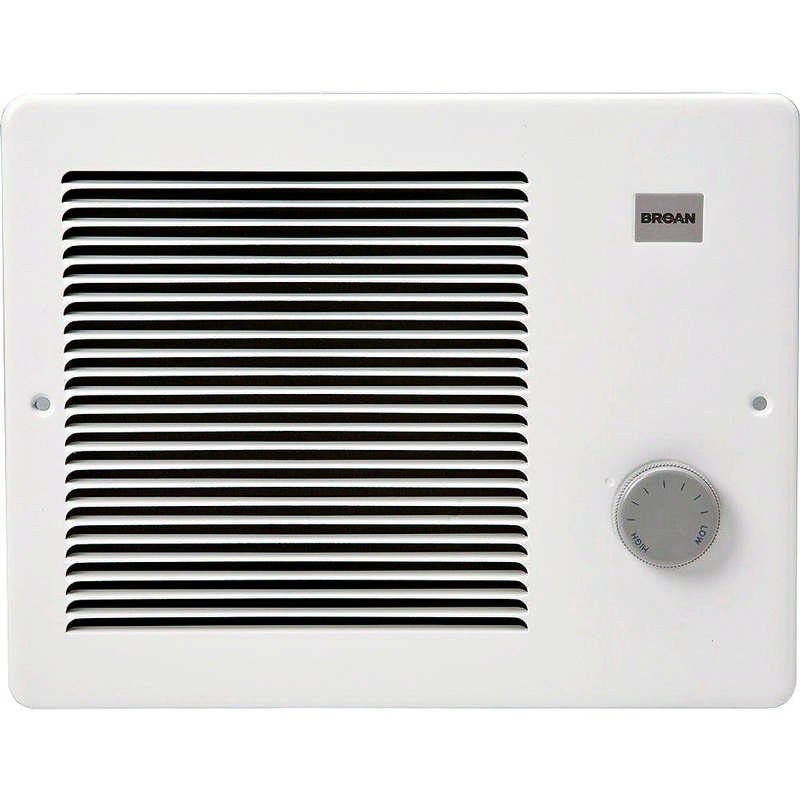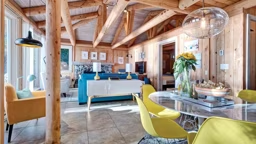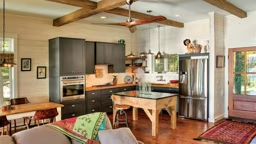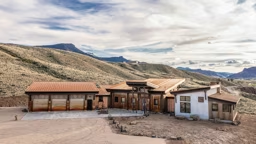
With heating and cooling gobbling up almost half the energy used in a typical U.S. home, finding the most efficient system to keep your cabin comfortable is important. If you’re building or remodeling a vacation cabin or second home, giving some thought to efficient heating and cooling will make your getaway affordable for years to come. Most cabins use propane, natural gas, electricity or heating oil to operate their heating, ventilation and air-conditioning (HVAC) systems. Your choice of fuel may depend on your cabin’s location and the time of the year you are there. For summer camp owners, a wood stove or fireplace may be all that’s needed to take the chill off early and late in the season. Still, if your future plans might extend the length of your stays or if you’re building with resale in mind, a more sophisticated HVAC system could be a wise choice.
 Heat an entire cabin – even provide continuous hot water – with a condensing gas boiler, like this one from the Rinnai Q Premier series.
Heat an entire cabin – even provide continuous hot water – with a condensing gas boiler, like this one from the Rinnai Q Premier series.
Hot trends in heating
Some vacation homes require a full furnace system; others may only need heat in a few specific areas, like bedrooms or baths. Among the choices for heating equipment today are highly efficient furnaces that help turn up the heat while dialing down the dollars spent. Condensing furnaces are better able to extract heat from the combustion and exhaust processes that happen within the furnace. With a conventional furnace, for instance, exhaust leaving the unit has a higher temperature than the much cooler exhaust exiting a condensing furnace. By pulling as much heat out of the furnace as possible, energy (and the money spent on it) stretches further. Another added plus with higher-efficiency furnaces is the presence of a heat recovery ventilator or energy recovery ventilator. These devices increase efficiency by warming fresh air with heat already present in a cabin’s return or exhaust air. Small HRV units are also available for bathroom exhaust fans. Finally, advanced gas valves in high-performance furnaces offer both high and low settings (or a range of settings) to adjust to the amount of heat needed. Older models have single-stage burners that are either on or off. Radiant in-floor heating can be appealing in a cold-climate vacation home. “It’s comfortable and low-maintenance,” says George Woodcock of Rinnai, a heating equipment manufacturer. Using an energy-efficient condensing boiler to heat the water used in the in-floor heating helps conserve energy. The same system can be used to provide hot water in a cabin, eliminating the need for a separate hot water heater. Wall-mounted electric heaters, like this one from Broan, can provide a boost of warmth in critical need areas like bathrooms. Step it up a notch: Choose a model with a programmable thermostat.
Wall-mounted electric heaters, like this one from Broan, can provide a boost of warmth in critical need areas like bathrooms. Step it up a notch: Choose a model with a programmable thermostat.
Make a hot spot
If you don’t need a whole-house heating system for your vacation home, you can choose from among many types of stand-alone heating units. Direct-vent wall furnaces and vent-free fan convectors are just two options for bringing heat to specific spots. “Direct-vent wall furnaces can heat the largest home or a space like a basement, it depends on the heat load and location,” Woodcock says. Vent-free units are best-suited for smaller vacation homes or an area like a three-season room or porch, he says. These newer wall furnaces have built-in safety features and are controlled by a thermostat to keep an even temperature. A gas line is all that’s needed for installation. Some units can be powered by propane, as well. Wall-mounted electric heaters can be an effective way to warm specific areas. Be sure to choose a model that’s properly sized for the square footage of the space to be heated. Look for traditional box-type or panel units with a programmable thermostat for efficient operation. Ductless “split” or “mini split” systems – widely used in Europe and Asia – and manufactured by companies like Fujitsu, Mitsubishi and Sanyo – are gaining ground in North America. These systems can provide both heat and air conditioning; for more information about how they work, read “Cool it down,” below.Make it work
If you have a ducted heating system already in place that may leave some rooms too cool and others too warm, there are ways to help improve its efficiency. Automated vents, like the Smart Vent from Keen, monitor the room temperature and air pressure, then redirect air by opening or closing vents to keep temperatures balanced throughout the home. Each vent is powered by batteries. The Ecovent system operates with the use of sensors plugged in to outlets in each room to measure temperature, humidity and air pressure. Based on these measurements, the system opens and closes vents as needed. Another efficient addition to an existing HVAC system is a programmable thermostat. These devices “learn” your heating and cooling preferences over time and automatically adjust your home’s temperature accordingly. They can also be operated remotely with the use of a smart phone app, allowing you to adjust your cabin’s heating and cooling before you even arrive for the weekend.Cool it down
The decision to include an air-conditioning system in your cabin will depend on its location and your personal preferences. For many cabin owners in the South and West, A/C is a necessity, not an option. A drawback of many whole-house ducted cooling systems is their lack of efficiency due in large part to leaky ducts that run through spaces in the home that aren’t heated or cooled. Ductless cooling options offer better return on energy spent. Split air conditioning systems are made up of an outdoor unit, which contains the condenser and compressor, and an indoor unit that can be mounted on a wall or ceiling or set on the floor. These systems are different from a traditional window air-conditioning unit, where the evaporator, condenser and compressor are combined. The indoor and outdoor units are connected by a line that runs refrigerant to the indoor unit and a line that drains moisture from condensation back outside. The units can be used for zone cooling, allowing for individual temperatures while avoiding the use of ducts.
A mini-split heating and cooling system, like the Fujitsu Halcyon, allows for a peaceful inside cabin environment because components like compressors and motors are installed outdoors.

Programmable and remote-monitoring thermostats, like the NEST, are great for cabiners. Key benefits: If you live in the Frostbelt, you can check your cabin’s temperature during winter to make sure your place isn’t freezing up. And for all cabiners, when you’re en route to you cabin, you can adjust the temp to make sure you’ll be comfy when you arrive.
Go natural
If you’re building a new cabin or planning a major remodel, you can design spaces to cool themselves – with some mechanical help. According to the U.S. Department of Energy, “ventilation is the least expensive and most energy-efficient way to cool a home.” Placing windows to allow for cross breezes and channeling hot air from the lower levels of your home up and out through upper level vents and fans will help keep your home comfortable. Fans on walls or ceilings circulate air to make rooms feel cooler. A whole-house fan provides cooling by pulling air in through windows and exhausting it out through the roof. The Department of Energy suggests enlisting the help of a professional to ensure the proper sizing and installation of a whole-house fan.Right from the start
An ounce of prevention, the saying goes, is worth a pound of cure: As you plan your cabin project, remember that thorough insulation, quality windows and attention to construction detail will help make your cabin as weathertight and easy to heat and cool as possible. Working with your site, existing trees and available sunlight will go a long way in helping the HVAC system you choose save as much energy as possible.ABOUT OUR AUTHOR
For writer Janice Brewster, cabin living requires a kayak, hiking boots and family to sit with around a campfire.










